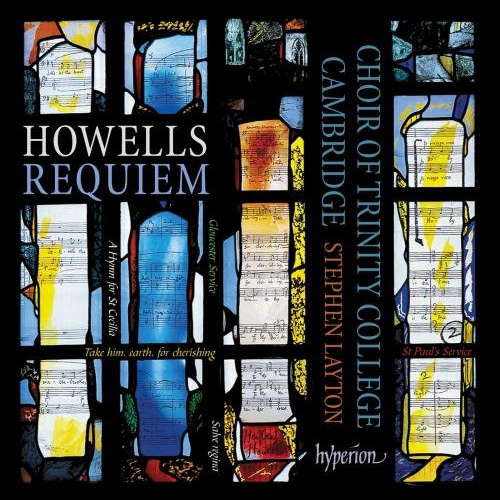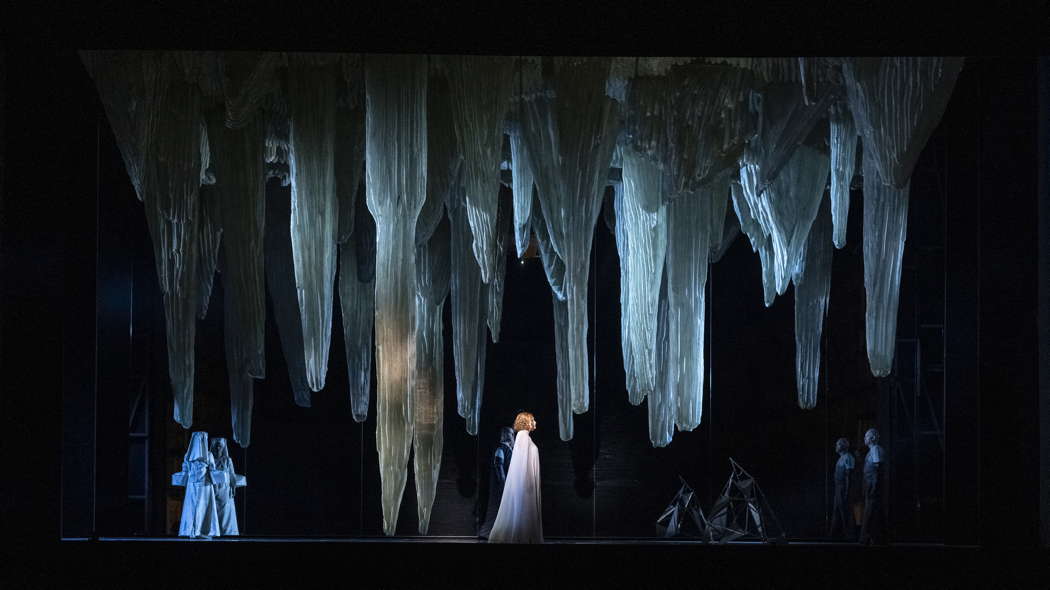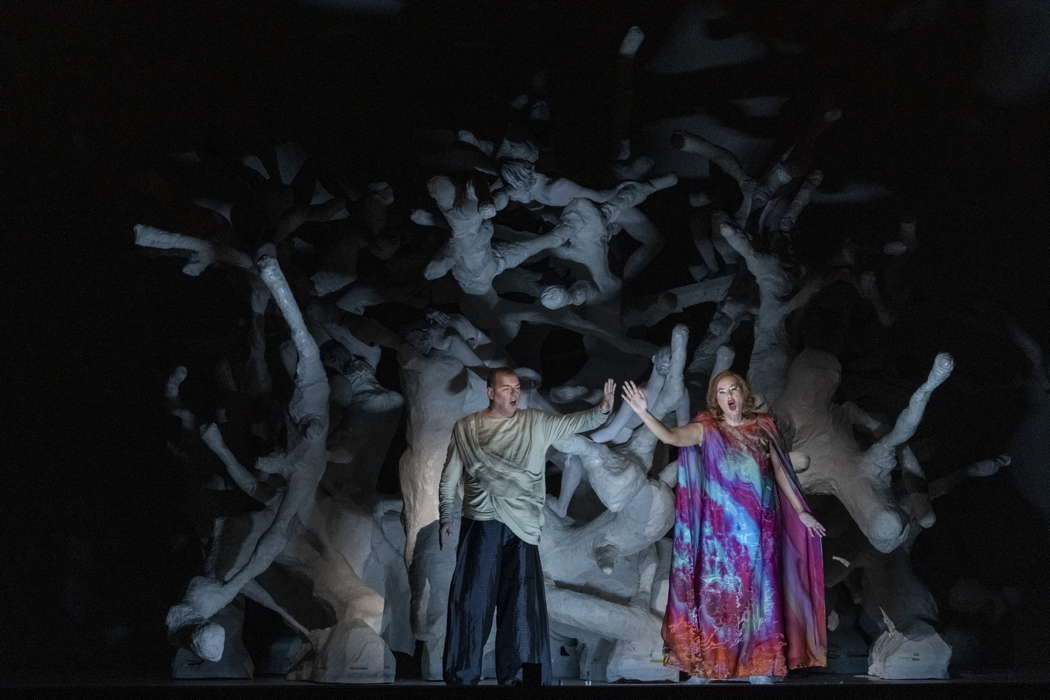 SPONSORED: CD Spotlight. Beautifully Apt - Choral music by Herbert Howells, heard by Robert Anderson.
SPONSORED: CD Spotlight. Beautifully Apt - Choral music by Herbert Howells, heard by Robert Anderson.
All sponsored features >>
Opium and Eros
Richard Wagner's 'Tristan und Isolde' in Bologna
pleases GIUSEPPE PENNISI
Tristan und Isolde opened the opera and ballet season in Bologna on 24 January 2020; I attended the 31 January performance in a Teatro Comunale sold out, despite the opera's five hour duration. Bologna prides itself on being a Wagnerian city, as it has hosted the Italian premieres of Lohengrin and Parsifal. In this and the next four seasons, the theatre stages an opera by Richard Wagner every year. A bold program since the staging of Wagner's works requires a strong production commitment. These will probably be co-productions: this Tristan und Isolde is the result of joint ventures with the Brussels Royal Theatre La Monnaie. Parsifal, scheduled for next season, is the production seen and heard recently in Palermo and reviewed in this magazine on 29 January. In relatively recent times. I have seen and listened to two very different productions of Tristan und Isolde at the Teatro Comunale of Bologna. In 1983, there was a much-appreciated staging of Yuri Ljubinov (with Zoltan Pesko on the podium) in which the story was set in 1850 in the Villa of Wesendonk - the Swiss textile industrialist whose wife Wagner fell in love with. In 1996 a staging imported from Hamburg, with Christian Thielemann on the podium and stage direction by Ruth Berghaus, carried the story on a spaceship and had strong political connotations. It was inundated with boos from the audience.
Although called by Wagner a 'three-act action', the action is all inner (and in long stories) more than on the stage. Let us remember the plot a nutshell. The Irish Princess Isolde is led by the young Tristan to marry his uncle Marke, King of Cornwall and Brittany. She wants to poison Tristan as the young man (whose life she saved) killed her fiancé, but her handmaid Brangäne replaces the death filter with that of love. Adultery and tragedy ensue. The desire of lovers to cancel each other is interrupted by being discovered and by mortal wounds inflicted in duel to the young man, even if King Marke understood and tolerated. From a musical point of view, Tristan changed the history of the method of composing, and began what would become the great contemporary music. Without the innovative charge, chromaticism and dissolution of traditional writing - Tristan's characteristic - there would be no contemporary music, from Debussy (whose Pelléas et Mélisande was mistakenly presented as 'anti-Tristan') to the dodecaphony of Zemlinski, Schoenberg, Malipiero and Dallapiccola. Nearly half a century earlier, Tristan opened what would have been one of the most important music schools of the twentieth century - 'the second Viennese school', to distinguish it from the 'first' of Haydn and Mozart's time. Wagner had studied composition for only six months and he could not play any instruments decently - he strummed the piano very badly. The chromatic writing is almost juxtaposed with the diatonic writing of Die Meistersinger, composed around the same time, and it accentuates the transparency of a work whose action takes place largely at night and in the soul of the protagonists.
Tristan und Isolde lends itself to multiple readings, from philosophical: Sinopolis exalted its Schopenhaurian side, to mythological: Karajan and Fortwängler, to erotic-sentimental: Solti, Böhm and Chung, to decadent: Mehta and Boulez. An essay would not be enough to touch on the mysteries of the confrontation between Isolde wilde, minnige Maid ('the wild lover') and the chaste Tristan. Never before Tristan und Isolde (and rarely after) has music theatre penetrated so deeply into eros - and into an eros where there is infinite passion but not sexual intercourse. There was a specific personal and artistic determinant. Wagner had interrupted scoring The Ring after the second scene of Siegfried's third act. Not only did he fear that the project would never be completed, but he could not express the erotic charge of the 45 minutes of ample and joyful orgasm with which the opera Siegfried closes. He needed to rise to the infinite joy of Die Meistersinger and to go to the depths of Tristan's eros. However, there is no sexual intercourse between the two lovers. (Wagner did not lack the experience of putting them into music, given various moments of The Ring.) Isolde was the woman of Morold and is the wife of King Marke. Tristan has never had a woman (as far as we know). On the long night of the second act - the first and last time you see them (almost) alone after their sudden falling in love - they invoke the union between eros and thanatos but, physically, they barely touch each other. They conceptualize love, indeed the sublime and complete lust (höchste Lust) considered possible only in the afterlife.
Eros and drugs are the centerpiece of the production. Ralf Pleger's directorial reading emphasizes that the love potion that the two protagonists consume at the end of the first act also contains opiates; at the time many musicians were on drugs - think, for example, of Berlioz - although it seems that Wagner consumed only light drugs, and rarely. Starting from this assumption, after drinking the potion, Tristan and Isolde see themselves and others differently. The action is all inner and dilated. So, the staging is eminently stylized. The scene designs of Alexander Polzin and the costumes of Wojciech Dziedzic take us into the abstract world. In the first act, there are a series of stalactites separating the two protagonists.

A scene from Act I of Tristan und Isolde in Bologna. Photo © 2020 Rocco Casaluci
In the second, the main set is a large sculpture that resembles a tree and resembles the neoclassical Laocoonte from the Vatican museums; from some of its branches, mimes come in erotic positions during the long love duet.

Stefan Vinke as Tristan and Ann Petersen as Isolde in Act II of Tristan und Isolde in Bologna. Photo © 2020 Rocco Casaluci
In Act III, the scene is a starry universe. The very measured and calligraphic acting was similar to that of Bob Wilson. This setting (and its logic) pleased the public and your reviewer.
The musical part, of course, is very important. At the helm of the orchestra of the Bologna Teatro Comunale, there was Juraj Valshuha who, from the introduction onwards, exalted the chromaticism of the score, juxtaposing it, for example, with the diatonic writing of the young sailor's song with which Act I begins. This was a sumptuous co-operation with great attention given to the voices, all at the highest level. The two lovers were Stefan Vinke and Ann Petersen - two great artists, experts in their respective roles. Ekaterina Gubanova's Brangäne and Albert Dohmen's King Marke were excellent, not to mention Martin Gantner's Kurwenal and Tommaso Caramia and Klodjan Kaani in various minor roles.
Copyright © 3 February 2020
Giuseppe Pennisi,
Rome, Italy

FURTHER INFORMATION: TRISTAN UND ISOLDE
FURTHER INFORMATION: RICHARD WAGNER




